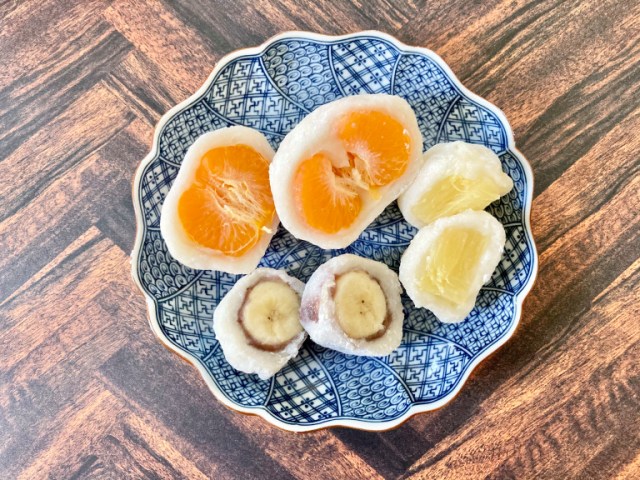
Today in the SoraKitchen we’re mixing nature’s candy with Japanese sweets.
Mochi comes in a lot of different forms, but just about everyone agrees that one of the best is daifuku. These sweet dumplings aren’t just delicious, they’re versatile too, and as proof today we’re going to make three different types of fruit daifuku that look and taste great.
For our dessert project, we used a make-it-yourself daifuku kit (available here) from Suehiroan, a traditional Japanese confectioner whose original shop is in Kawasaki. You can get pretty much everything that’s in the kit at just about any Japanese market, though.
The kit contains:
● Mochi sheets
● Powdered mochi
● Koshi an (sweet red bean paste)
● Shiro an (sweet white bean paste)
● Cooking oil
● A kiriito (cutting string)
One of the most common fruit daifuku fillings is strawberries, but since they’re out of season right now, we decided to go with banana, orange, and pineapple.
▼ Yes, canned pineapples aren’t necessarily “in season” either, but we were really, really craving pineapple.
Daifuku are meant to be eaten in about two bites, so you’ll want to slice your fruit accordingly. Once you’ve done that, the next step is to coat each piece with sweet bean paste.
We opted for red bean paste for the banana and white for the orange and pineapple. One thing to keep in mind is that if the surface of the fruit is damp, the bean paste will have a tough time sticking to it, so if you’re using canned fruit, you’ll want to remove any excess syrup before you start applying the coating.
Next, you’re going to want to dab a bit of oil and powdered mochi on your fingertips. That’s because it’s time to wrap the bean paste-covered fruit in mochi, and pre-treating your fingertips will keep the mochi from sticking to your hands. Cut off a piece of mochi, knead it for a bit, and then wrap it around the fruit.
This can be a little tricky, because mochi is sticky, sometimes stubborn stuff. Keep at it, though, an eventually you’ll have a plate of fruit daifuku!
Technically, these are ready to eat right here. Depending on your commitment to presentation, though (something that Japanese confectioners pride themselves on), there’s one more thing to do. Since the fruit is a full 50 percent of what makes fruit daifuku so delicious, let’s cut each dumpling in half.
▼ We used our kit’s kiriito, but a sharp knife should do the trick too.
Not only does this give the diner a sneak-peak at the flavor they can expect, the frosty white of the outer mochi layer creates for a nice contrast with the filling, making the fruit’s cross-section look mouthwateringly vivid in color.
And of course, as always, the best accompaniment to Japanese sweets is a fresh cup of green tea.
In terms of flavor, all three of our fruit daifuku tasted great, but we were especially satisfied with the banana ones. They’re definitely going on the list for the next batch we make, but since you can make fruit daifuku with any kind of fruit, we’re looking forward to continuing our experimenting too.
Photos ©SoraNews24
● Want to hear about SoraNews24’s latest articles as soon as they’re published? Follow us on Facebook and Twitter!
[ Read in Japanese ]

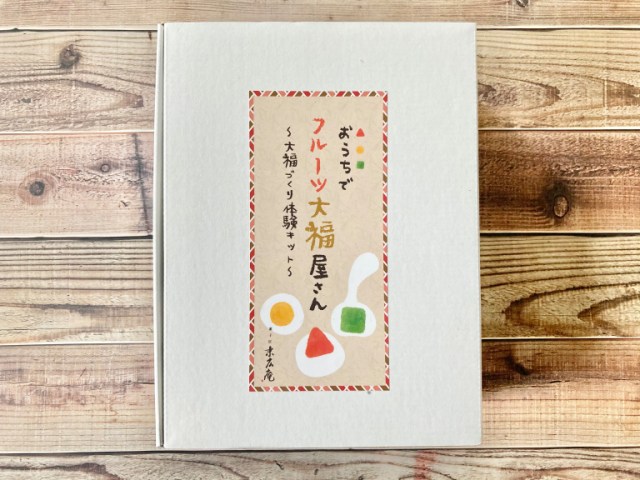
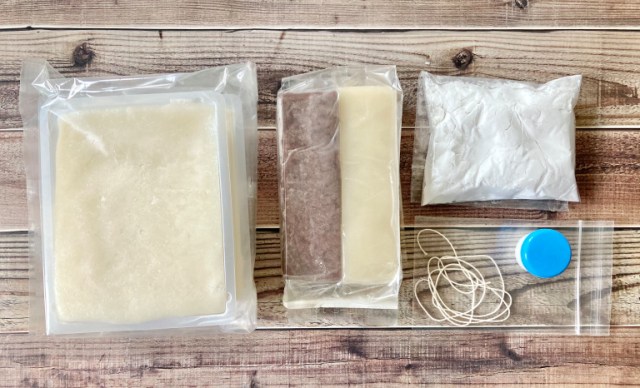
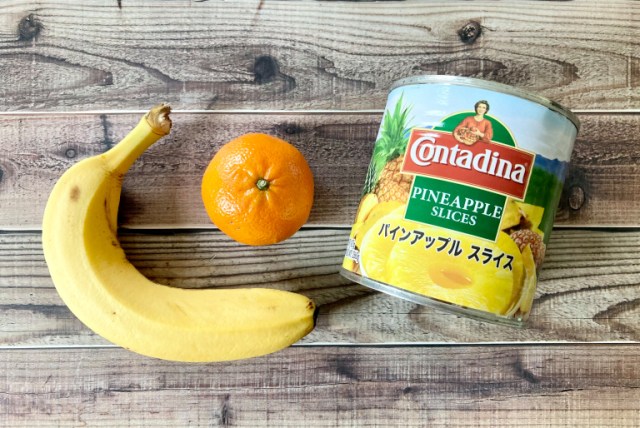
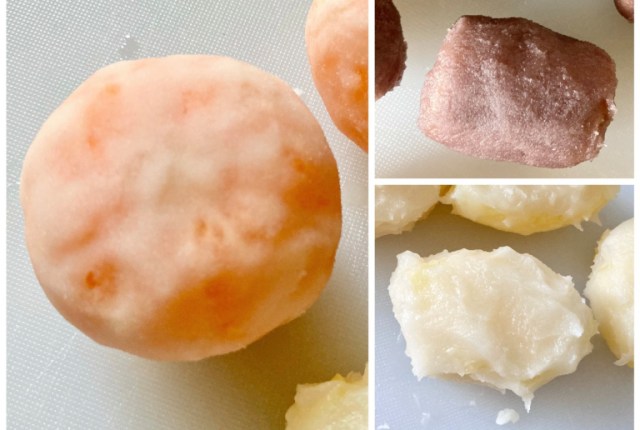
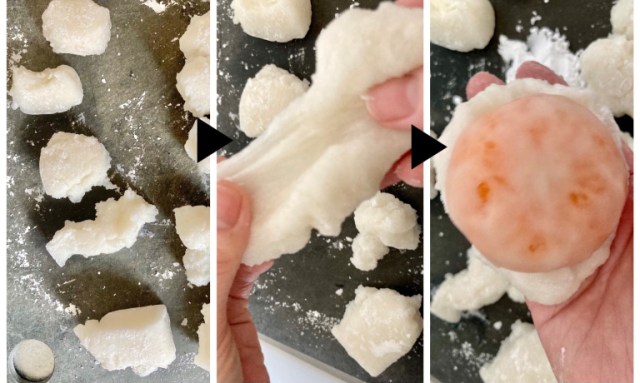
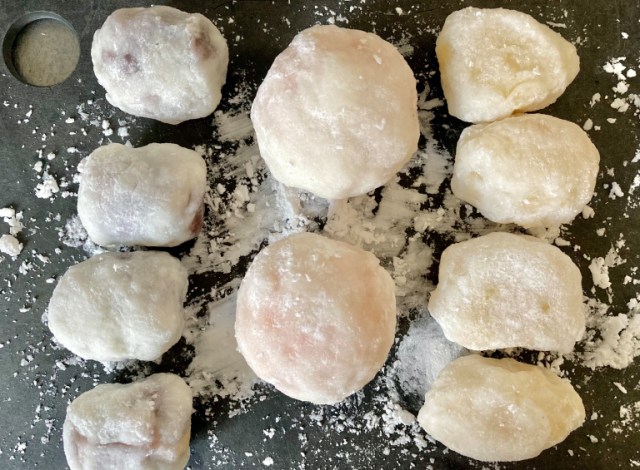
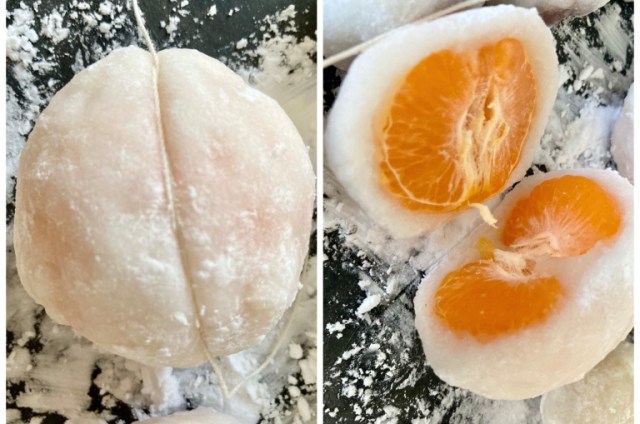
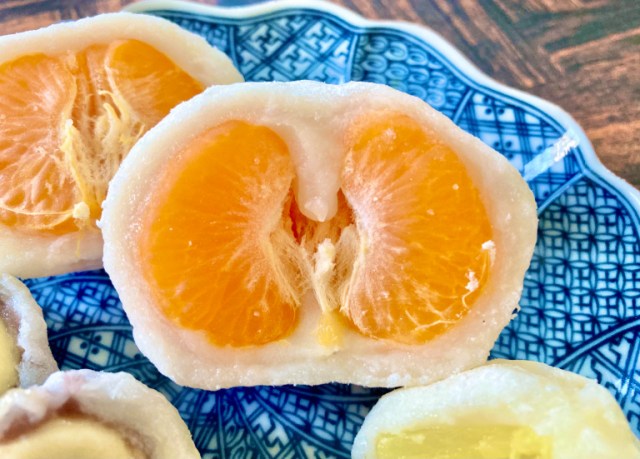
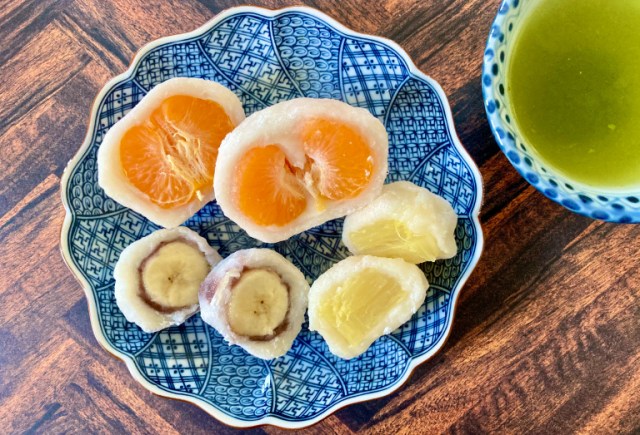
 Taste-testing every single sakura sweet and cherry blossom drink we could find at Mujirushi
Taste-testing every single sakura sweet and cherry blossom drink we could find at Mujirushi New Mochi Cream Doughnuts from Mister Donut pay homage to Japanese confectionery
New Mochi Cream Doughnuts from Mister Donut pay homage to Japanese confectionery We tried Japan’s Strawberry Daifuku? liqueur, one of three dessert-themed liqueurs
We tried Japan’s Strawberry Daifuku? liqueur, one of three dessert-themed liqueurs We became Japanese sweet chefs for a day with Popin Cooking’s DIY wagashi set
We became Japanese sweet chefs for a day with Popin Cooking’s DIY wagashi set Our Japanese reporter tries Yukimi Daifuku mochi ice cream for the first time (probably)
Our Japanese reporter tries Yukimi Daifuku mochi ice cream for the first time (probably) Foreigner’s request for help in Tokyo makes us sad for the state of society
Foreigner’s request for help in Tokyo makes us sad for the state of society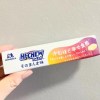 Do Hi-Chew-flavor Hi-Chews have a reason to exist?【Taste test】
Do Hi-Chew-flavor Hi-Chews have a reason to exist?【Taste test】 Seaside scenery, history, and so many desserts on Yokohama’s Akai Kutsu【Japan Loop Buses】
Seaside scenery, history, and so many desserts on Yokohama’s Akai Kutsu【Japan Loop Buses】 Japanese city loses residents’ personal data, which was on paper being transported on a windy day
Japanese city loses residents’ personal data, which was on paper being transported on a windy day Red light district sushi restaurant in Tokyo shows us just how wrong we were about it
Red light district sushi restaurant in Tokyo shows us just how wrong we were about it Japan’s summertime towelket pillowcases are even better with the addition of Ghibli stars【Photos】
Japan’s summertime towelket pillowcases are even better with the addition of Ghibli stars【Photos】 Suntory x Super Mario collaboration creates a clever way to transform into Mario【Videos】
Suntory x Super Mario collaboration creates a clever way to transform into Mario【Videos】 Should you add tartar sauce to Japanese curry rice? CoCo Ichi makes diners an unusual offer
Should you add tartar sauce to Japanese curry rice? CoCo Ichi makes diners an unusual offer Haku is…Chihiro’s dead brother? Studio Ghibli fans blown away by Spirited Away theory
Haku is…Chihiro’s dead brother? Studio Ghibli fans blown away by Spirited Away theory Ghibli Park now selling “Grilled Frogs” from food cart in Valley of Witches
Ghibli Park now selling “Grilled Frogs” from food cart in Valley of Witches McDonald’s new Happy Meals offer up cute and practical Sanrio lifestyle goods
McDonald’s new Happy Meals offer up cute and practical Sanrio lifestyle goods Japanese ramen restaurants under pressure from new yen banknotes
Japanese ramen restaurants under pressure from new yen banknotes French Fries Bread in Tokyo’s Shibuya becomes a hit on social media
French Fries Bread in Tokyo’s Shibuya becomes a hit on social media Studio Ghibli releases new action figures featuring Nausicaä of the Valley of the Wind characters
Studio Ghibli releases new action figures featuring Nausicaä of the Valley of the Wind characters New private rooms on Tokaido Shinkansen change the way we travel from Tokyo to Kyoto
New private rooms on Tokaido Shinkansen change the way we travel from Tokyo to Kyoto Tokyo Tsukiji fish market site to be redeveloped with 50,000-seat stadium, hotel, shopping center
Tokyo Tsukiji fish market site to be redeveloped with 50,000-seat stadium, hotel, shopping center Beautiful Ghibli sealing wax kits let you create accessories and elegant letter decorations【Pics】
Beautiful Ghibli sealing wax kits let you create accessories and elegant letter decorations【Pics】 Studio Ghibli releases Kiki’s Delivery Service chocolate cake pouches in Japan
Studio Ghibli releases Kiki’s Delivery Service chocolate cake pouches in Japan New definition of “Japanese whiskey” goes into effect to prevent fakes from fooling overseas buyers
New definition of “Japanese whiskey” goes into effect to prevent fakes from fooling overseas buyers Our Japanese reporter visits Costco in the U.S., finds super American and very Japanese things
Our Japanese reporter visits Costco in the U.S., finds super American and very Japanese things All-you-can-drink Starbucks and amazing views part of Tokyo’s new 170 meter-high sky lounge
All-you-can-drink Starbucks and amazing views part of Tokyo’s new 170 meter-high sky lounge More foreign tourists than ever before in history visited Japan last month
More foreign tourists than ever before in history visited Japan last month New Pokémon cakes let you eat your way through Pikachu and all the Eevee evolutions
New Pokémon cakes let you eat your way through Pikachu and all the Eevee evolutions Disney princesses get official manga makeovers for Manga Princess Cafe opening in Tokyo
Disney princesses get official manga makeovers for Manga Princess Cafe opening in Tokyo Sales of Japan’s most convenient train ticket/shopping payment cards suspended indefinitely
Sales of Japan’s most convenient train ticket/shopping payment cards suspended indefinitely Sold-out Studio Ghibli desktop humidifiers are back so Totoro can help you through the dry season
Sold-out Studio Ghibli desktop humidifiers are back so Totoro can help you through the dry season Japanese government to make first change to romanization spelling rules since the 1950s
Japanese government to make first change to romanization spelling rules since the 1950s Ghibli founders Toshio Suzuki and Hayao Miyazaki contribute to Japanese whisky Totoro label design
Ghibli founders Toshio Suzuki and Hayao Miyazaki contribute to Japanese whisky Totoro label design Doraemon found buried at sea as scene from 1993 anime becomes real life【Photos】
Doraemon found buried at sea as scene from 1993 anime becomes real life【Photos】 Tokyo’s most famous Starbucks is closed
Tokyo’s most famous Starbucks is closed One Piece characters’ nationalities revealed, but fans have mixed opinions
One Piece characters’ nationalities revealed, but fans have mixed opinions We asked a Uniqlo employee what four things we should buy and their suggestions didn’t disappoint
We asked a Uniqlo employee what four things we should buy and their suggestions didn’t disappoint Princesses, fruits, and blacksmiths: Study reveals the 30 most unusual family names in Japan
Princesses, fruits, and blacksmiths: Study reveals the 30 most unusual family names in Japan Fried mochi ice cream ramen appears in Japan to simultaneously hit three comfort food bullseyes
Fried mochi ice cream ramen appears in Japan to simultaneously hit three comfort food bullseyes Godiva releases first-ever chocolate daifuku in Japan
Godiva releases first-ever chocolate daifuku in Japan Häagen-Dazs Japan comes out with sticky-sweet new line of ice cream containing … mochi!
Häagen-Dazs Japan comes out with sticky-sweet new line of ice cream containing … mochi! Mochi ice cream ramen: Noodles will never be the same again
Mochi ice cream ramen: Noodles will never be the same again 7-Eleven’s edible cat paw proves Japanese convenience store sweets are on a whole other level
7-Eleven’s edible cat paw proves Japanese convenience store sweets are on a whole other level “Glossy green tea donuts” sound weird, look amazing in Mr. Donut team-up with Kyoto matcha master
“Glossy green tea donuts” sound weird, look amazing in Mr. Donut team-up with Kyoto matcha master Hida City’s tempura mochi proves that almost anything tastes better as tempura 【SoraKitchen】
Hida City’s tempura mochi proves that almost anything tastes better as tempura 【SoraKitchen】 Mochi, the silent New Year killer, leaves nine dead and 128 hospitalized
Mochi, the silent New Year killer, leaves nine dead and 128 hospitalized Rare vending machine at Japan’s oldest shrine sells…divine crepes!
Rare vending machine at Japan’s oldest shrine sells…divine crepes! Delicious cherry blossom-flavored treats are in full-bloom in Japanese stores
Delicious cherry blossom-flavored treats are in full-bloom in Japanese stores New Japanese KitKats feature sakura sake and a traditional cherry blossom dessert
New Japanese KitKats feature sakura sake and a traditional cherry blossom dessert Happy Halloween! Now eat your eyeball mochi
Happy Halloween! Now eat your eyeball mochi Michelin-approved Japanese chef teaches us two gourmet-standard dishes using ice cream and toast
Michelin-approved Japanese chef teaches us two gourmet-standard dishes using ice cream and toast Mister Donut Glossy Green Tea shows true beauty is on the inside, even for desserts【Taste test】
Mister Donut Glossy Green Tea shows true beauty is on the inside, even for desserts【Taste test】 Instant Japanese dessert soup with an Akita twist instantly changes our image of great shiruko
Instant Japanese dessert soup with an Akita twist instantly changes our image of great shiruko
Leave a Reply